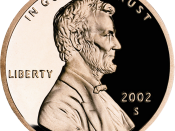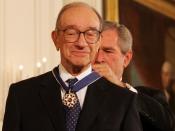A frequently asked question by a customer is "Can you break a hundred dollar bill?" If this request has been granted, why do the cashiers take the bill and turn it into a biology experiment? Between pouring a liquid on the note and/or holding it up to the light to check for authenticity, is our currency system in danger? As of the beginning of 1996, the Chairman of the Federal Reserve and the Secretary of the United States Treasury, prove their economic wizardry by making the new one hundred dollar bill nearly impossible to counterfeit in attempt to protect our economy. This is just the first step in improving our currency system.
Counterfeiting U.S. currency is an illegal practice that has has been around for years and, unfortunately,is getting worse. "Last year, ...the Secret Service cooperated with the Italian authorities' seizure of $43.8 million in counterfeit U.S. currency, Germany's capture of more than $19 million in counterfeit cash, and the Canadian authorities; seizure of than $129 million in counterfeit U.S.
currency." (Gomez, Bertha. "Officials Say..") In a small town north of Chicago, two high school seniors were arrested for the use of counterfeit bills. With the use of the internet and a color printer, these two teenagers were able to create and pass their counterfeit twenty dollar bills through the high school cafeteria but were later arrest by police after trying to use their money at a local Taco Bell. If teenagers are finding ways to counterfeit money, that should tell someone that we need to do something to protect our economy for the future.
In attempt to enhance our currency system, the one hundred dollar bill was completely redesigned last year and released at the beginning of this year. This new bill contains a security thread, a watermark,


